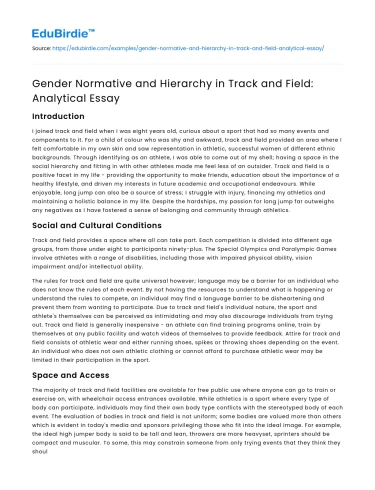Introduction
I joined track and field when I was eight years old, curious about a sport that had so many events and components to it. For a child of colour who was shy and awkward, track and field provided an area where I felt comfortable in my own skin and saw representation in athletic, successful women of different ethnic backgrounds. Through identifying as an athlete, I was able to come out of my shell; having a space in the social hierarchy and fitting in with other athletes made me feel less of an outsider. Track and field is a positive facet in my life - providing the opportunity to make friends, education about the importance of a healthy lifestyle, and driven my interests in future academic and occupational endeavours. While enjoyable, long jump can also be a source of stress; I struggle with injury, financing my athletics and maintaining a holistic balance in my life. Despite the hardships, my passion for long jump far outweighs any negatives as I have fostered a sense of belonging and community through athletics.
Social and Cultural Conditions
Track and field provides a space where all can take part. Each competition is divided into different age groups, from those under eight to participants ninety-plus. The Special Olympics and Paralympic Games involve athletes with a range of disabilities, including those with impaired physical ability, vision impairment and/or intellectual ability.
Save your time!
We can take care of your essay
- Proper editing and formatting
- Free revision, title page, and bibliography
- Flexible prices and money-back guarantee
The rules for track and field are quite universal however; language may be a barrier for an individual who does not know the rules of each event. By not having the resources to understand what is happening or understand the rules to compete, an individual may find a language barrier to be disheartening and prevent them from wanting to participate. Due to track and field's individual nature, the sport and athlete's themselves can be perceived as intimidating and may also discourage individuals from trying out. Track and field is generally inexpensive - an athlete can find training programs online, train by themselves at any public facility and watch videos of themselves to provide feedback. Attire for track and field consists of athletic wear and either running shoes, spikes or throwing shoes depending on the event. An individual who does not own athletic clothing or cannot afford to purchase athletic wear may be limited in their participation in the sport.
Space and Access
The majority of track and field facilities are available for free public use where anyone can go to train or exercise on, with wheelchair access entrances available. While athletics is a sport where every type of body can participate, individuals may find their own body type conflicts with the stereotyped body of each event. The evaluation of bodies in track and field is not uniform; some bodies are valued more than others which is evident in today's media and sponsors privileging those who fit into the ideal image. For example, the ideal high jumper body is said to be tall and lean, throwers are more heavyset, sprinters should be compact and muscular. To some, this may constrain someone from only trying events that they think they should participate in due to their body, rather than what they are interested in.
Competition is offered by the division of disciplines into biologically sex-specific events and there are no mix-gender events or separate categories for non-binary or transgender individuals. Excluding transgender athlete has undergone both hormonal and surgical gender reassignment therapy, those who do not identify on the spectrum of the gender binary must still compete within their biological sex category. Individuals may find this binary construct difficult and may be more likely to not participate in track and field as a result.
Gender Normative and Hierarchy
Track and field's principles are formed on the basis of strength, power, and speed; all are socially constructed to be masculine attributes. Women's participation in athletics depicts a picture of discrimination and marginalization; 1992 marks the start of women being able to compete in track and field (Dutch, 2016). As women have yet to meet the standards of male performers, claims of biological inadequacy have lead to a hierarchy within the sport (Dutch, 2016). These ideals of biological difference create a construction of 'dualisms which render bodies as pairs of opposites in which [one may think] of bodies as distinct (and often unequal) in worth' (KPE200, Fall 2019). These inequities in track and field have found that female athletes experience disparities in opportunities, media coverage, financial incentives and sponsorship in comparison to male athletes.
Practices within athletics are implicated in the social construction of gender, thus further implicating a hierarchy between masculinity and femininity. Female athletes participating in track and field where the physical demands of their events are contrary to society's ideal image of femininity brings about a discourse surrounding the body. Society's gender-normative is displayed within track and field where female athletes are seen to adopt feminine identifiers; hyperfeminine clothing, makeup and/or hiding markers of masculine characteristics such as muscularity. These attributes of sexual attractiveness are deemed as necessary for female track athletes to access the same opportunities and sponsorships as male track athletes. The penalty of the normative is imposed in the competition for a greater capital reward which produces further dividing practices for women in track and field.






 Stuck on your essay?
Stuck on your essay?

